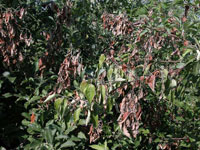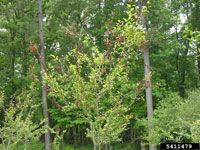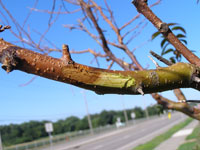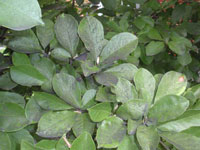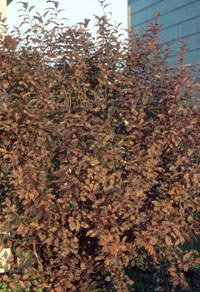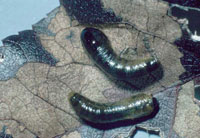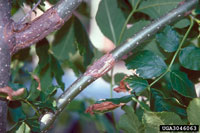Extension > Garden > Diagnose a problem > What's wrong with my plant? > Deciduous > Cotoneaster > Leaves discolored brown to black
Cotoneaster > Leaves > Leaves discolored brown to black
1 of 4
Fire blight
Erwinia amylovora
- Infected flowers appear water-soaked, shrivel and turn brown or black
- Leaves wilt, turn reddish brown; appear as though scorched by fire and cling to twigs
- Infected shoots turn brown and bend into a shepherds' crook
- Cankers on older branches cause bark to be dark, cracked and sunken <
- More information on fire blight
2 of 4
Sooty Mold
- Black, brown or gray soot-like covering on leaf surfaces, twigs or branches
- Sticky, shiny secretions on leaves from sap-sucking insects (e.g., wooly apple aphid)
- Insects or signs of insect damage (distorted, pin-prick feeding marks, etc.) may be seen on leaves or twigs above the most heavily affected moldy areas.
- More information on Sooty Mold
3 of 4
Pear Sawfly (Pear Slug)
Caliroa cerasi
- Larvae feed on upper surface of leaf between the veins, "windowpaning" the leaf as they feed
- Damaged leaves often have a grayish appearance before turning brown
- Larvae normally feed about 4 weeks beginning in June; a second generation may start in August
- Larvae are one half inch long, shiny and slug-like and are normally dark olive green in color
- More information on Pear Sawfly
4 of 4
Botryosphaeria canker
Botryosphaeria dothidea
- Leaves on one or more branches wilt, die and turn brown
- Bark on affected branches is darker, cracked, or blistered at the site of the canker
- Wood beneath the canker is dark brown
- Common on shrubs stressed by drought, winter injury and other factors
- More information on Botryosphaeria canker



